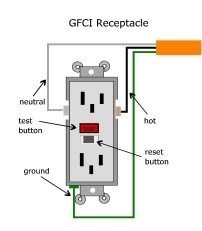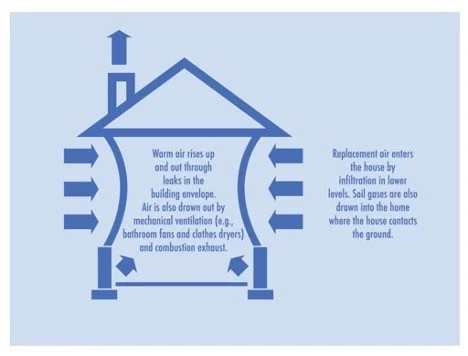Owning a home can be expensive. There always seems to be something to fix, repair, or replace. The list of monthly expenses can add up in a hurry, and utility bills can be a big part of those monthly expenses.
The illustration above demonstrates the common areas of air infiltration into and out of a home.
Focusing on energy efficiency in your home can add up to savings. People usually catch the easy ones, like shutting off lights, pulling shades or curtains to keep the sun out, and trying not to waste water. Some of these issues may be pointed out by your home inspector during the course of a home inspection.
Air Leakage Explained
One of the least understood energy wasters in a home is air leakage. These are all of those little gaps, cracks, seals, and openings in your home that let air leak into and out of the conditioned space of your home. It may not seem like much, but every little bit of air leakage adds up to wasted energy and, in extreme cases, difficulty keeping some areas of your home comfortable.
Energy efficiency methods in home construction have advanced greatly over the years. We have all heard about how “tight” new homes are. This is a result of products like house wraps, foam sealants, and even things as benign as the electrical boxes that house switches, lights, and outlets. Newer construction does a far better job at addressing air leakage than homes built in the past when energy was cheap.
Common Areas for Air Leaks
Windows, doors, exterior wall penetrations, light fixtures in the ceiling, as well as ducts, fireplaces, pet doors, and vents, are some of the most common areas where air leakage can occur in your home.
By performing an inspection on your home, many of these troubled areas can be discovered. Obviously, if you see a gap between your front door and its frame, it is an air leak and should be resolved. Weather stripping can be either added or replaced to seal these kinds of gaps. Sometimes you may notice that curtains move slightly when the wind blows. Inspecting your windows for air leaks and repairing them can add up to a lot of savings.
There are some areas in your home, however, where air leaks are not so easy to see. One option is to hire a specialist who can perform a blower door test to evaluate your home’s energy efficiency. The process of a blower door test places an insert in a doorway that contains a fan that pulls a suction on the house. This allows the technician to calculate the air loss based on pressure differentials. Using other tools, such as an infrared camera, will help the technician locate areas where outside air is being drawn into the home. A visual home inspection by the blower door technician may also uncover problem areas.
Blower door installed at the front door of a home
Low-Air Leakage Pros and Cons
Reducing uncontrolled air leakage will save you money. In the summer, when it is hot and humid, air leakage allows hot air to come into the house and the cool, conditioned air to leak out. Under these conditions, your air conditioning has to work extra hard to maintain the ideal temperatures in your home. In the wintertime, the cold air gets in and the heated air escapes. The end result in either case is higher energy bills and added wear and tear on your air conditioning and heating equipment.
An airtight home improves your energy efficiency and helps you save money. Reducing air leakage means that your home maintains a pleasant, comfortable environment with fewer fluctuations in temperature.
In humid areas of the country, the continuous drawing of moist air into a home can lead to potential mold issues that can affect the health of the home’s occupants. If the moisture intrusion is severe and continuous, it can result in interior damage within the walls and costly repairs.
One of the biggest concerns about an airtight home that has been realized over the years is the decrease in natural ventilation. With reduced ventilation, airborne particles, dust, mold, and germs can build up inside the home, creating poor air quality. Sometimes this can become extreme enough to create what is called a “sick home.” This is obviously a legitimate concern and must be balanced to optimize energy efficiency and not compromise the healthy air within the home.
Proper ventilation is important when it comes to airtight homes. A concept that builders use is “Build Tight, Ventilate right.” There are two systems that are used in new construction that help to maintain proper ventilation within a home. Heat Recovery Ventilators (HRV) and Energy Recovery Ventilators (ERV) are systems that manage the air exchange within the home by pulling fresh air from the outside and expelling stale air from the inside.
Maintaining this equipment is crucial to its proper operation. Our home inspectors commonly find HRVs and ERVs that are either poorly maintained or, in some cases, have never been maintained. The filters and the heat exchangers may have dust and insects built up to a point where the system is nearly or completely plugged. Again, this is wasting energy as well as creating wear and tear on the system. Poorly maintained systems are called out as in need of attention on our home inspection reports.
Summary
Uncontrolled air leakage into and out of your home can be costly and inefficient. Performing a visual home inspection will uncover some of the more obvious issues within your home. If you want to fine-tune and optimize the heating and cooling efficiency of your home, you may want to hire a professional to perform a blower door test.
At HomePro Inspections, our home inspectors are trained to inspect all areas of the home. When performing a home inspection, our home inspectors are looking for obvious issues regarding air leakage. These areas of concern will be documented on your home inspection report and recommended for resolution.
Visit our website to learn more or to schedule your home inspection in the Rochester, Owatonna, and Faribault, MN areas. You can contact us today at (507) 202-8942 or utilize our online “Schedule Now” feature to set up an appointment.


















































